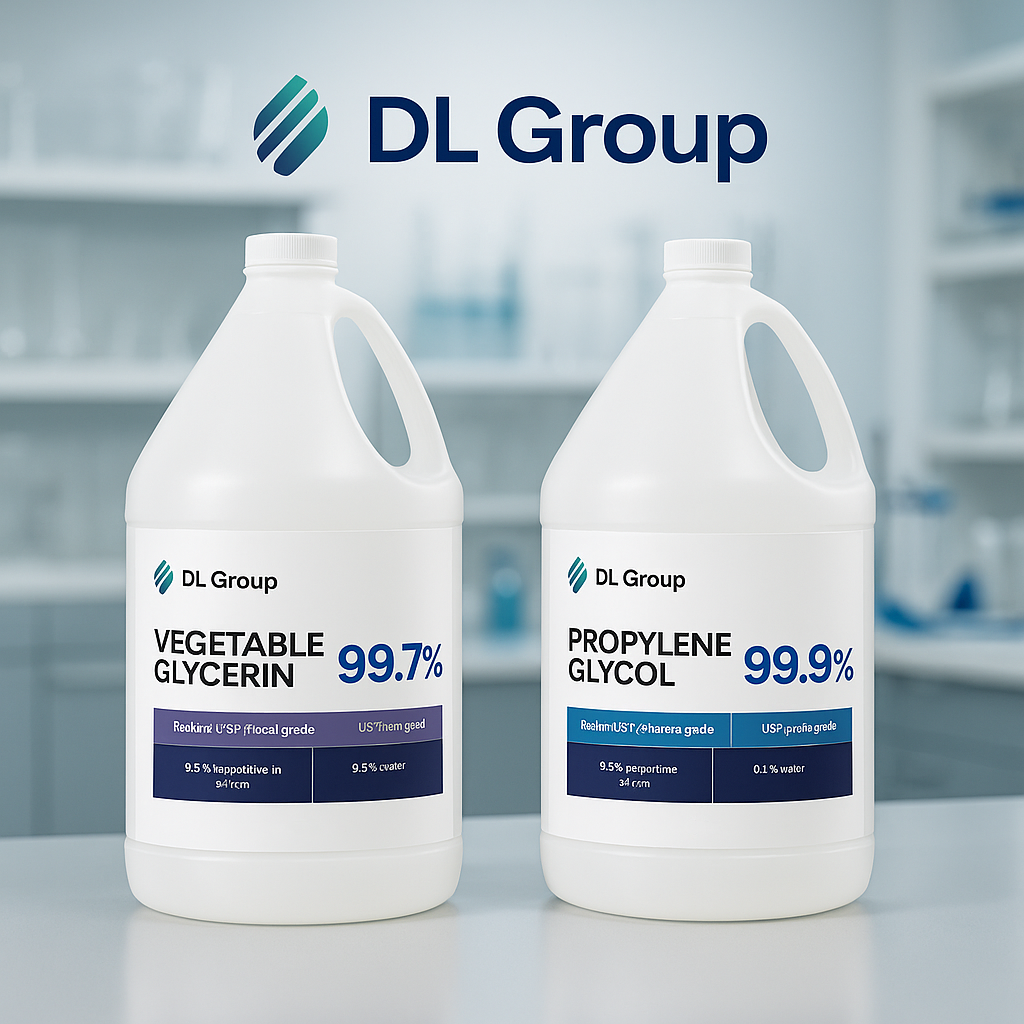
5 Essential Benefits of Glycerin and Propylene Glycol: DL Group’s Wholesale Advantage
Share
Introduction
At DL Group, we offer premium Vegetable Glycerin (99.7%) and Propylene Glycol USP Grade (99%) to meet a wide range of industrial, pharmaceutical, and cosmetic needs. From moisturizing agents to solvents and more, this article explores their uses within the context of our product range—and why clients trust us for quality and reliability.
Overview of DL Group’s Glycerin & Propylene Glycol Offerings
DL Group is a Canadian-owned wholesale chemical supplier based in Ontario, offering lab-tested, technical-grade ingredients at competitive bulk pricing. Our catalog includes:
Available in 4L bottles and case quantities, these products are ideal for both small-scale and industrial use.
Chemical Properties & Manufacturing Standards
Vegetable Glycerin (VG) 99.7%
- Plant-derived, high-purity glycerol
- Viscous, sweet, colorless, and odorless
- Acts as a humectant and emollient in food, pharmaceuticals, and cosmetics
Propylene Glycol USP Grade 99%
- Synthetic, clear, and odorless
- FDA-recognized as GRAS (Generally Recognized as Safe)
- Functions as a solvent, stabilizer, carrier, and moisture-retention agent
Primary Applications
Cosmetics & Personal Care
- Glycerin: Used in lotions, soaps, shampoos, and conditioners for hydration and skin feel
- Propylene Glycol: Acts as a carrier, enhances texture, and stabilizes formulations
Pharmaceuticals & OTC
- Common in eye drops, creams, gels, and syrups
Food & Beverage Industry
- Propylene Glycol: Anticaking agent, flavor stabilizer, humectant, and thickener
- Glycerin: Adds sweetness, moisture, and texture in confectionery and bakery products
Industrial & Technical Use
- Propylene Glycol: Used in antifreeze, fog machines, and coatings
- Glycerin: Used in mold prevention, lubrication, and chemical manufacturing
Benefits for Customers
- High Purity & Lab Testing: >99% purity with full regulatory compliance
- Packaging & Pricing: 4L jugs and bulk cases available with volume discounts
- Documentation: Access SDS and Certificates on our Resources Page
Glycerin vs Propylene Glycol: A Quick Comparison
| Property | Glycerin | Propylene Glycol |
|---|---|---|
| Viscosity | High (thicker) | Low (thinner) |
| Moisture Retention | Strong | Moderate |
| Solvent Capability | Mild | Broad-spectrum |
| Edibility & Gentleness | Ideal for food and skincare | Versatile but more technical |
| GRAS/Safety Status | Non-toxic, edible | Low risk, widely used |
Handling, Storage & Safety
- Storage: Keep sealed in dry, shaded environments at room temperature
- Documentation: Find SDS and certifications on the Resources Page
Why Choose DL Group?
- Canadian-Owned & Operated: Based in Concord, ON, with fast national distribution
- Responsive Support: Access to lab reports and knowledgeable customer service
- Reliable Wholesale Supply: Bulk pricing, consistent quality, and documentation
- Ongoing Education: Explore industry trends via our blog
Frequently Asked Questions
-
Q1: Is glycerin safe for food use?
A: Yes. It’s GRAS-approved and used in food as a sweetener and preservative. -
Q2: What do these ingredients do in skincare?
A: Glycerin hydrates and softens skin; propylene glycol stabilizes and carries actives. -
Q3: Are DL Group’s products vegan and kosher?
A: Yes. Glycerin is plant-based; propylene glycol is kosher-certified. -
Q4: Can propylene glycol be used in pharmaceuticals?
A: Yes. It’s a standard solvent in creams, gels, and oral meds. -
Q5: How should I store these ingredients?
A: Keep in sealed containers at room temperature, away from light. -
Q6: Where can I get SDS and documentation?
A: Visit our Resources Page.
Conclusion
From skincare to food production, DL Group’s high-purity glycerin and propylene glycol serve a wide range of industries. With lab-tested quality, bulk packaging, and excellent customer service, we’re your trusted Canadian partner in wholesale chemical supply.
